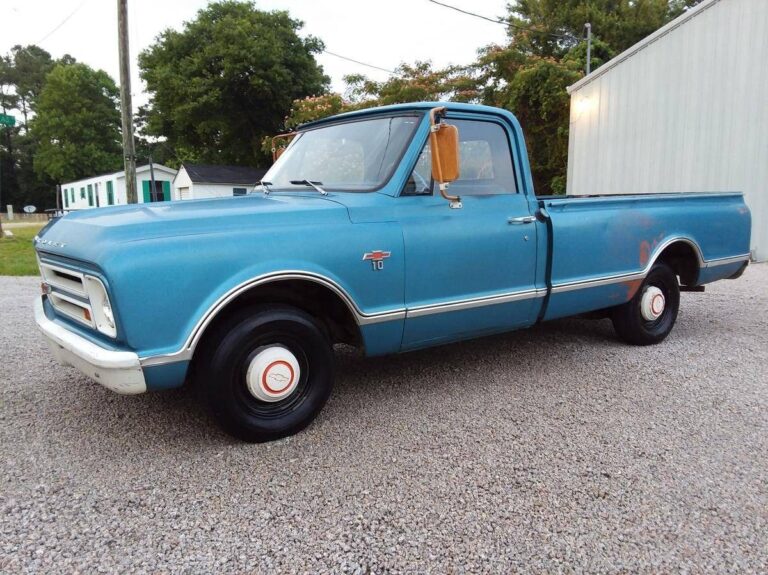Typical GM Car: Decoding the Enduring American Archetype
Typical GM Car: Decoding the Enduring American Archetype cars.truckstrend.com
The term "Typical GM Car" evokes a rich tapestry of automotive history, perception, and engineering. It doesn’t refer to a single model or a specific year, but rather a composite archetype—a set of characteristics, design philosophies, and ownership experiences that have broadly defined General Motors vehicles for decades. From the humble sedan to the formidable truck, the "Typical GM Car" represents a blend of practicality, widespread availability, often robust powertrains, and a distinctly American sensibility in its approach to design and comfort. Understanding this archetype means appreciating the sheer breadth of GM’s influence on the automotive landscape, its evolution through various eras, and the core values that have often underpinned its products.
This article aims to dissect the essence of the "Typical GM Car," exploring its defining attributes, its journey through technological advancements, and what prospective buyers and current owners can expect from these ubiquitous machines.
Typical GM Car: Decoding the Enduring American Archetype
The GM DNA: Core Characteristics
At the heart of the "Typical GM Car" lies a foundational approach to engineering and manufacturing that has emphasized reliability, ease of maintenance, and broad appeal. Historically, this meant:
- Robust Powertrains: General Motors has long been synonymous with powerful and durable engines, particularly its V8s (like the ubiquitous Small Block Chevrolet and later the LS series) and reliable automatic transmissions (e.g., Turbo-Hydramatic 350/400, 4L60E). These powertrains were designed for longevity and strong low-end torque, making them ideal for everything from family sedans to work trucks. Even as GM diversified into V6 and four-cylinder engines, the emphasis often remained on dependable performance.
- Body-on-Frame Construction (for trucks/SUVs): While sedans transitioned to unibody construction, GM’s trucks and larger SUVs (like the Silverado, Tahoe, Suburban) maintained their body-on-frame architecture. This provided immense durability, towing capability, and a rugged feel, becoming a hallmark of their utility vehicles.
- Widespread Availability and Serviceability: GM’s massive production volumes and extensive dealer network meant that parts were readily available and service was accessible across North America. This contributed to lower maintenance costs and a higher degree of DIY friendliness for many models.
Design Philosophy and Interior Comfort

The design evolution of the "Typical GM Car" has mirrored American tastes, moving from conservative and utilitarian to more expressive and sophisticated.
- Spacious and Comfortable Interiors: A consistent theme has been the focus on interior space and comfort. Older models were often characterized by plush, bench-seat interiors, while modern GM vehicles prioritize ergonomic design, intuitive layouts, and increasingly premium materials. The ride quality often leaned towards comfort, absorbing road imperfections effectively, particularly in larger sedans and SUVs.
- Mainstream Aesthetics: For much of its history, GM’s design language aimed for broad appeal, often resulting in conservative yet recognizable aesthetics. While some designs were criticized for being bland or having "plastic cladding" in certain eras, recent years have seen GM push for more distinctive and dynamic styling across its brands, from the sharp lines of Cadillac to the rugged appeal of GMC.
Performance and Powertrain Legacy
The performance narrative of a "Typical GM Car" is often dominated by its engine heritage.
- V8 Dominance: The V8 engine, especially the Chevrolet Small Block, is arguably the most iconic powertrain in automotive history, powering millions of GM cars and trucks for decades. It offered a compelling blend of power, reliability, and a distinctive exhaust note.
- Evolution Beyond the V8: While the V8 remains a core offering in many trucks and performance vehicles, GM has significantly invested in fuel-efficient V6s (like the 3.6L LGX/LFX) and advanced four-cylinder engines (like the Ecotec series) with technologies such as direct injection and turbocharging. These modern engines offer a balance of performance and improved fuel economy, reflecting changing market demands.
- Automatic Transmissions: GM has historically been a leader in automatic transmission technology, from the legendary Turbo-Hydramatic series to modern multi-speed automatics and now continuously variable transmissions (CVTs) and electric drive units in EVs. These transmissions are typically tuned for smooth shifts and durability.
Technology and Innovation (and Perceived Lags)
GM’s technological journey has been a mix of pioneering innovation and, at times, a perceived lag behind certain competitors.
- Pioneering Features: GM was an early adopter of technologies like OnStar telematics, which provided safety and connectivity services long before they became commonplace. They also led in areas like variable valve timing and active fuel management (cylinder deactivation) to improve efficiency.
- Modern Advancements: Current GM vehicles are equipped with a full suite of advanced driver-assistance systems (ADAS) like adaptive cruise control, lane-keeping assist, and automatic emergency braking. Their infotainment systems, such as Chevrolet Infotainment 3 and Cadillac User Experience (CUE), offer smartphone integration (Apple CarPlay, Android Auto) and over-the-air updates.
- Electrification: GM is making a significant push into electric vehicles (EVs) with its Ultium battery platform, aiming to electrify its entire lineup. Models like the Chevrolet Bolt EV/EUV, Cadillac Lyriq, and GMC Hummer EV represent the cutting edge of their technological ambition.
Ownership Experience: Maintenance, Parts, and Value
Owning a "Typical GM Car" generally comes with a predictable and often positive ownership experience.
- Ease of Maintenance: Thanks to their widespread popularity, parts for most GM vehicles are abundant and often more affordable than for many import brands. The vast network of dealerships and independent mechanics familiar with GM platforms contributes to ease of service. Many common maintenance tasks are also relatively straightforward for the DIY enthusiast.
- Resale Value: Resale value can vary significantly across GM’s diverse portfolio. Trucks and SUVs (e.g., Chevrolet Silverado, Tahoe, GMC Sierra, Yukon, Cadillac Escalade) often command strong resale values due to their utility and demand. Mainstream sedans and some older models may see more depreciation, but their initial affordability often balances this out.
- Reliability Perceptions: Historically, GM has faced criticism for certain reliability issues (e.g., some electrical problems, specific transmission variants). However, modern GM vehicles consistently score well in reliability studies, demonstrating significant improvements in quality control and engineering.
Evolution and Adaptability
The "Typical GM Car" is not static; it has continuously evolved to meet changing consumer preferences and regulatory demands. From the dominance of sedans in the mid-20th century to the current SUV and crossover craze, GM has adapted its product lineup. The current pivot towards electric vehicles underscores GM’s commitment to remaining relevant in a rapidly changing automotive landscape, carrying forward the spirit of accessibility and broad appeal into the future.
Practical Advice for Prospective Buyers and Owners
If you’re considering a GM vehicle or own one, here’s some practical advice:
- Research Specific Models: While the "Typical GM Car" shares characteristics, each model (e.g., Malibu, Equinox, Silverado) has its own specific features, common issues, and ownership costs. Use online forums, consumer reports, and professional reviews to gather detailed information.
- Leverage Aftermarket Support: The vast aftermarket for GM vehicles means endless possibilities for customization, performance upgrades, and readily available replacement parts. This can make ownership more affordable and personalized.
- Understand Maintenance Schedules: Adhere to the recommended maintenance schedule in your owner’s manual. Regular oil changes, fluid checks, and tire rotations are crucial for longevity, especially for models known for their robust powertrains.
- Consider Used Vehicle Inspections: For pre-owned GM vehicles, a pre-purchase inspection by a trusted mechanic familiar with GM platforms is highly recommended to identify any potential issues before purchase.
Challenges and Solutions
Even a "Typical GM Car" comes with its set of challenges, often rooted in historical perceptions or specific design choices.
- Historical Perceptions of Quality: Older generations of GM vehicles sometimes faced criticism for interior materials or certain reliability issues.
- Solution: Modern GM vehicles have made significant strides in material quality, fit-and-finish, and overall reliability, often ranking highly in consumer satisfaction and dependability surveys. Focus on current model years for improved quality.
- Fuel Economy (Historically): The prevalence of larger V8 engines meant some older GM vehicles were not known for their fuel efficiency.
- Solution: Current GM models offer a wide range of highly efficient powertrains, including turbocharged four-cylinders, advanced V6s, and a growing lineup of fuel-efficient hybrids and fully electric vehicles (Ultium platform).
- Resale Value Variability: While trucks and SUVs hold value well, some sedans historically depreciated faster.
- Solution: Research specific models. Strong demand for utility vehicles ensures good resale. For sedans, competitive pricing and features can still offer excellent value, especially on the used market.
Illustrative Price Ranges for Categories of GM Vehicles
Since "Typical GM Car" is an archetype and not a specific model, it’s impossible to provide a single price. Instead, here are illustrative price ranges for categories of GM vehicles that embody different aspects of what might be considered "typical" in the market today, for both new and used conditions. These ranges are approximate and can vary widely based on trim level, options, condition, mileage, and market demand.
| Vehicle Type | Example GM Models | New Price Range (MSRP) | Used Price Range (3-5 years old) |
|---|---|---|---|
| Compact Sedan | Chevrolet Malibu, Chevrolet Cruze (dis.) | $25,000 – $32,000 | $12,000 – $20,000 |
| Mid-size Crossover | Chevrolet Equinox, GMC Terrain | $28,000 – $40,000 | $18,000 – $28,000 |
| Full-size Truck | Chevrolet Silverado 1500, GMC Sierra 1500 | $38,000 – $70,000+ | $25,000 – $55,000+ |
| Full-size SUV | Chevrolet Tahoe, GMC Yukon, Cadillac Escalade | $56,000 – $110,000+ | $35,000 – $85,000+ |
| Electric Vehicle | Chevrolet Bolt EV/EUV, Cadillac Lyriq | $27,000 – $65,000+ | $18,000 – $45,000+ |
Note: Prices are estimates and subject to change based on market conditions, trim levels, and regional variations. Used prices depend heavily on mileage, condition, and optional features.
Frequently Asked Questions (FAQ) about Typical GM Cars
Q1: What makes a car a "Typical GM Car"?
A1: A "Typical GM Car" isn’t one specific model, but rather a representation of common traits found across GM’s diverse brands (Chevrolet, GMC, Buick, Cadillac). These often include robust powertrains (historically V8s), a focus on interior comfort and space, widespread availability of parts, a strong dealer network, and a blend of mainstream appeal with practical utility.
Q2: Are "Typical GM Cars" reliable?
A2: Modern GM vehicles generally rank well in reliability studies. While some older models had specific known issues (e.g., certain transmission or electrical problems), GM has made significant strides in quality and durability in recent decades. Researching specific models and years is always recommended.
Q3: Are parts expensive for GM cars?
A3: Generally, parts for common GM vehicles are widely available and often more affordable than for many European or specialized import brands, thanks to GM’s massive production volumes and extensive aftermarket support.
Q4: Do GM cars hold their value well?
A4: Resale value varies. GM’s trucks (Silverado, Sierra) and large SUVs (Tahoe, Yukon, Escalade) tend to hold their value exceptionally well due to high demand and utility. Mainstream sedans may depreciate more, but their competitive initial pricing often makes them good value.
Q5: What are the main advantages of owning a "Typical GM Car"?
A5: Key advantages include widespread service availability, generally affordable parts, a comfortable ride, often powerful and durable engines, and a strong emphasis on utility and practicality, especially in their truck and SUV lineups.
Q6: Has the "Typical GM Car" changed over time?
A6: Absolutely. The "Typical GM Car" has evolved significantly. While core values like reliability and practicality remain, modern GM vehicles feature advanced safety technologies, sophisticated infotainment systems, more refined designs, and a strong push towards fuel efficiency and electrification (EVs).
Conclusion
The "Typical GM Car" is more than just a vehicle; it’s a living symbol of American automotive engineering, reflecting decades of innovation, adaptation, and an unwavering commitment to meeting the needs of a diverse consumer base. From the roaring V8s that defined generations to the silent hum of the new Ultium-powered EVs, GM vehicles have consistently offered a compelling blend of utility, comfort, and accessibility. While the specific characteristics may shift with each passing decade, the underlying ethos of a dependable, widely available, and value-conscious vehicle remains at the heart of the "Typical GM Car," ensuring its enduring relevance in the automotive world.




